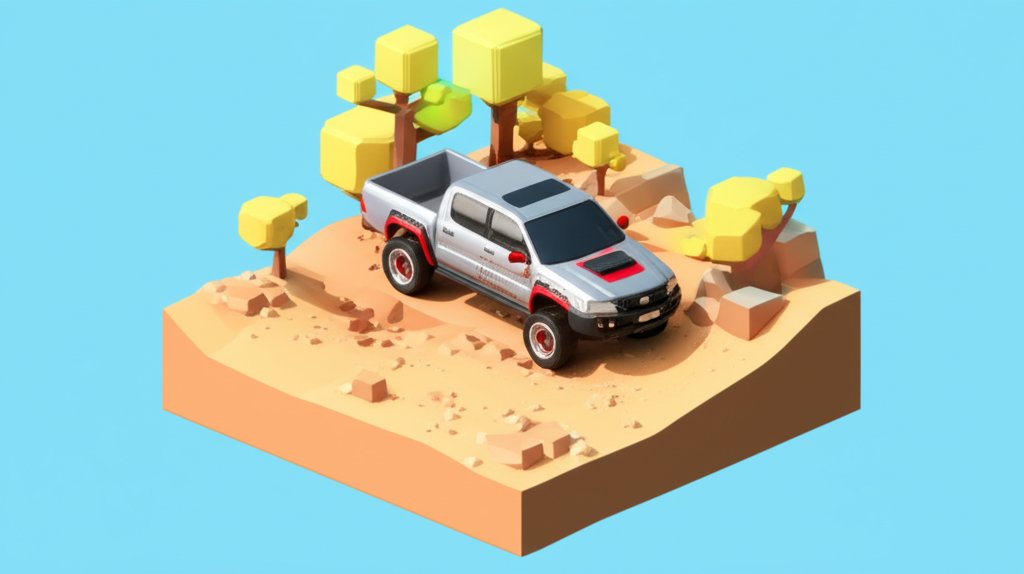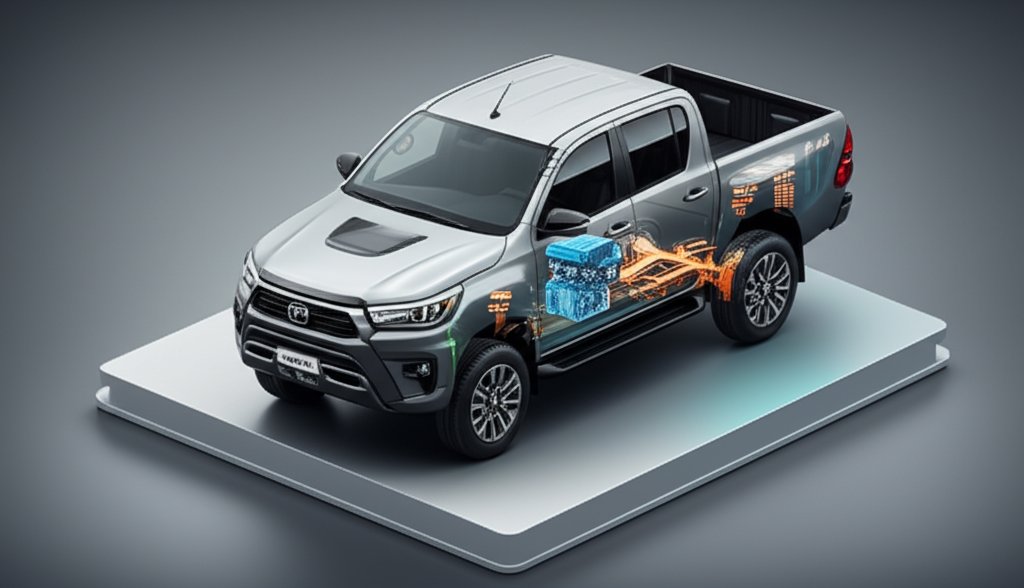For over half a century, one name has consistently echoed through the toughest terrains, the harshest climates, and the most demanding job sites around the globe: the Toyota Hilux. More than just a pickup truck, it’s an undisputed legend, an symbol of unyielding durability, and a cultural phenomenon. Yet, for all its fame, there are many facts about Toyota Hilux that remain shrouded in mystery, hidden beneath its rugged exterior. Get ready, automotive enthusiasts, as we peel back the layers to reveal the truly shocking truths and hidden secrets behind this iconic vehicle, designed to dominate roads, trails, and indeed, Google search results.
The Unbreakable Legend: Durability & Extreme Expeditions

The Toyota Hilux isn’t just built tough; it’s practically indestructible. Its reputation for resilience isn’t just marketing hype; it’s forged in real-world extremes and famously demonstrated under the most brutal conditions.
Top Gear’s Infamous Indestructibility Test
Perhaps the most famous testament to the Hilux’s legendary toughness comes from the BBC’s Top Gear. In a series of segments that have since become iconic, Jeremy Clarkson attempted to destroy an ordinary, used 1988 Toyota Hilux pickup truck through increasingly extreme methods. These weren’t mere bumps and scrapes; they were full-on assaults designed to render any vehicle scrap.
- Drowning: Submerged in the Bristol Channel for five hours.
- Crashing: Driven into a tree, then a shed.
- Flaming: Set on fire.
- Smashing: Dropped from a 240-foot building.
- Crushing: Placed on top of a 23-story tower block that was then imploded.
Despite being bent, battered, and burned, the Hilux consistently started again with only basic tools and minor repairs. This epic saga cemented the Toyota Hilux as the “Chuck Norris of pickup trucks” in the public consciousness, proving its extraordinary resilience and unwavering toughness.
Beyond its televised trials, many more fascinating aspects contribute to the Hilux’s enduring legacy, which you can explore in our article on Toyota facts.
Poles Apart: Conquering Earth’s Extremes
The Hilux’s spirit of adventure extends far beyond television stunts. This remarkable automotive marvel has conquered both the North and South Poles, enduring temperatures plummeting below -40°C and navigating treacherous, unyielding ice and snow.
- North Pole Expedition (2007): Top Gear itself used a specially modified Arctic Trucks Hilux to drive to the magnetic North Pole, becoming the first vehicle to achieve this feat. The modifications were extensive but the core Hilux chassis and drivetrain proved invaluable.
- South Pole Logistics (Ongoing): Arctic Trucks, an Icelandic company specializing in extreme vehicle modifications, routinely uses Hilux models for logistical support and scientific expeditions in Antarctica. These vehicles are vital lifelines in one of the planet’s most inhospitable environments, showcasing the Hilux’s ability to operate reliably where failure is not an option.
These expeditions aren’t just about reaching a destination; they’re about surviving it. The Hilux’s consistent performance in these frozen landscapes, from its ability to start in extreme cold to its robust chassis handling glacial traverses, speaks volumes about its engineering integrity.
Military & Humanitarian Service: A Global Workhorse
Beyond civilian adventures, the Toyota Hilux has an undeniable presence in some of the world’s most challenging operational environments. Its reputation for ruggedness, ease of repair, and ability to run on various fuel qualities has made it a vehicle of choice for:
- Non-Governmental Organizations (NGOs): Delivering humanitarian aid to remote or conflict-affected regions where infrastructure is non-existent.
- Military & Paramilitary Forces: Utilized for reconnaissance, transport, and mounting light weaponry, famously leading to the term “Toyota War” in the late 1980s, highlighting its pivotal role in armed conflicts due to its reliability and adaptability.
This widespread adoption by critical organizations underscores a simple truth: when lives and missions depend on a vehicle that will always get the job done, the Hilux is often the first choice.
Global Phenomenon: Market Dominance & Cultural Impact
With an astonishing global footprint, the Toyota Hilux isn’t merely a vehicle; it’s an economic force and a cultural icon, particularly outside of North America.
Worldwide Sales Dominance
With over 19 million units sold in more than 180 countries and regions since its introduction in 1968, the Toyota Hilux has undeniably established its dominance on a global scale. This isn’t just a high number; it represents generations of trust and loyalty. From the bustling markets of Southeast Asia to the vast plains of Africa, and the rugged outback of Australia to the agricultural heartlands of South America, the Hilux is often the top-selling pickup truck. Its popularity stems from a blend of:
- Unmatched Reliability: A reputation for rarely breaking down, and when it does, being relatively simple and inexpensive to fix.
- Versatility: Capable of handling everything from heavy hauling and farming to daily commuting and extreme off-roading.
- Longevity: Many Hilux models remain in service for decades, a testament to their build quality.
A Truly International Truck: Manufacturing Hubs
The Hilux is not just sold worldwide; it’s built worldwide. The Toyota Hilux is currently manufactured in at least six different countries, including Thailand, South Africa, Argentina, Malaysia, Pakistan, and others. This multinational production strategy ensures:
- Localized Adaptation: Vehicles can be tailored to specific regional tastes, regulations, and environmental conditions.
- Efficiency: Reduced shipping costs and import duties, making the Hilux more competitive in diverse markets.
- Economic Impact: Creating jobs and fostering automotive expertise in local economies.
This global manufacturing network is a testament to the Hilux’s universal appeal and Toyota’s commitment to serving its diverse customer base effectively.
The Hilux Enigma in the US: A Rarity’s Allure
While the Toyota Hilux enjoys phenomenal success almost everywhere else, it’s a surprisingly difficult (and expensive) vehicle to acquire in the United States. This scarcity isn’t due to a lack of demand or capability, but primarily due to:
- The “Chicken Tax”: A 25% tariff on imported light trucks (a historical trade dispute originating from chicken imports), which makes importing the Hilux financially unviable for Toyota.
- The Toyota Tacoma: To circumvent the “Chicken Tax,” Toyota decided to design and build a separate, US-market-focused pickup truck – the Tacoma – specifically for North America. While sharing some DNA, the Tacoma is distinct, larger, and designed for US consumer preferences, which value larger trucks and different feature sets.
This makes the Hilux an almost mythical vehicle for American enthusiasts, a symbol of robust, no-nonsense utility that remains just out of reach, adding to its allure and cult status.
Engineering Marvels: Under the Hood & Beyond
The Toyota Hilux’s legendary status isn’t just about its exterior toughness; it’s rooted in meticulous engineering that prioritizes function, durability, and capability.
Purpose-Built Architecture: Body-on-Frame Strength
At the core of the Hilux’s robustness is its separate frame construction. Unlike many modern vehicles that use a unibody design, the Hilux maintains a traditional body-on-frame chassis. This architecture provides several critical advantages for a pickup truck:
- Extreme Durability: The ladder frame can withstand immense torsional stress and impacts, crucial for off-roading, heavy loads, and surviving the kind of abuse the Top Gear team dished out.
- Load-Carrying Capacity: The strong frame is ideal for supporting heavy payloads in the bed without compromising structural integrity.
- Towing Capability: It provides a solid foundation for significant towing capacities.
- Repairability: Body-on-frame vehicles are generally easier and cheaper to repair after impacts, as the body and chassis are separate components.
Suspension Tuned for Any Terrain
The Hilux’s suspension system is a masterclass in balancing comfort, capability, and load-bearing prowess:
- Front Suspension: Typically features a double-wishbone/coil spring setup. This provides precise steering control, a relatively comfortable ride, and excellent articulation for off-road obstacles.
- Rear Suspension: Employs a rigid axle/leaf spring arrangement. This classic pickup truck setup is renowned for its strength, simplicity, and ability to handle heavy loads without sagging, making it perfect for both work and adventure.
This combination ensures that the Toyota Hilux can deliver a stable and controlled ride, whether traversing rough construction sites, navigating rutted trails, or cruising on paved highways.
Power & Efficiency: The Engine Lineup
Over its many generations, the Toyota Hilux has offered a diverse range of reliable powertrains, primarily focusing on robust diesel engines known for their torque and fuel efficiency, alongside capable petrol options:
- Diesel Engines: Modern Hilux models often feature 2.4-liter and 2.8-liter four-cylinder turbo-diesel engines (e.g., 1GD-FTV and 2GD-FTV). These engines are engineered for high torque at low RPMs, essential for hauling and off-road climbing, while maintaining impressive fuel economy for their class.
- Petrol Engines: Depending on the market, some Hilux variants offer petrol engines, such as a 2.7-liter four-cylinder or even a 4.0-liter V6, providing smoother operation and higher horsepower figures for those who prefer petrol power.
The focus on proven engine technologies ensures long-term reliability and performance under diverse operating conditions, making the Toyota Hilux a truly global automotive solution.
Evolution of an Icon: From Humble Beginnings to Modern Powerhouse
The Toyota Hilux has come a long way since its debut, continuously evolving to meet changing demands while retaining its core values of reliability and ruggedness.
The Genesis: “High Luxury” Concept
When the first Toyota Hilux rolled off the production line in March 1968, its name was derived from “High Luxury.” While today it’s synonymous with rugged utility, the initial intent was to combine the practicality of a utility vehicle with a level of comfort and refinement not typically found in work trucks of its era. This foundational concept of blending workhorse capability with user comfort has guided its evolution ever since.
Generations of Innovation and Refinement
The Hilux has seen eight distinct generations, each building upon the last while introducing significant advancements:
- First Generation (1968-1972): Introduced as a compact pickup truck, replacing the Stout in some markets.
- Second Generation (1972-1978): Focused on improved comfort and safety.
- Third Generation (1978-1983): Introduced four-wheel-drive variants, solidifying its off-road prowess.
- Fourth Generation (1983-1988): More refined styling, independent front suspension on some models. This is the generation famously used in the Top Gear tests.
- Fifth Generation (1988-1997): Enhanced cabin space and more powerful engines.
- Sixth Generation (1997-2005): Increased focus on passenger comfort and safety, moving towards a more SUV-like interior.
- Seventh Generation (2004-2015): A significant redesign, becoming larger and more imposing, introducing the IMV platform (Innovative International Multi-purpose Vehicle) which also underpinned the Fortuner SUV and Innova MPV. This marked its true global dominance.
- Eighth Generation (2015-Present): The current iteration, featuring advanced safety technologies, modern infotainment, and more powerful yet efficient engines, further enhancing its automotive appeal.
Each generation has carefully balanced incremental improvements with revolutionary changes, ensuring the Hilux remains at the forefront of the pickup truck market.
Modern Technology at Your Fingertips
While renowned for its toughness, the modern Toyota Hilux doesn’t compromise on contemporary conveniences and safety features. Features like:
- Advanced Infotainment Systems: Touchscreen displays with Apple CarPlay and Android Auto integration for seamless smartphone connectivity.
- Navigation & Reverse Camera: Standard on many higher trims (e.g., Hilux Raider models), enhancing convenience and safety during parking and maneuvering.
- Keyless Entry & Push-Button Start: Adding a touch of premium comfort.
The Evolution of Safety: Toyota Safety Sense
Beyond creature comforts, Toyota has made significant strides in passive and active safety. The inclusion of Toyota Safety Sense (TSS) on newer Hilux models provides a suite of advanced driver-assistance systems:
- Pre-Collision System (PCS): Detects potential frontal collisions with vehicles or pedestrians.
- Lane Departure Alert (LDA): Warns the driver if the vehicle unintentionally drifts from its lane.
- Adaptive Cruise Control (ACC): Maintains a set speed and distance from the vehicle ahead.
- Road Sign Assist (RSA): Recognizes road signs and displays them on the multi-information display.
These technologies enhance the Toyota Hilux’s appeal, making it not just a capable workhorse but also a safe and comfortable family vehicle for many.
Hidden Secrets & Special Mentions: Beyond the Standard Hilux
The influence of the Toyota Hilux extends into surprising collaborations and specialized variants, further cementing its unique place in automotive history.
The Volkswagen Taro: An Unexpected Alliance
In a surprising historical footnote, Volkswagen once teamed up with Toyota to build a pickup truck based on the Hilux in the 1980s. The result was the Volkswagen Taro, primarily sold in Europe. This rebadged Hilux was a direct consequence of VW needing a robust, reliable pickup truck rapidly, and Toyota’s platform was the clear choice. This unique partnership highlighted the universal recognition of the Hilux’s exceptional qualities and Toyota’s manufacturing prowess.
Special Editions: From Rally Racers to Arctic Conquerors
The inherent capability of the Hilux makes it a perfect base for specialized modifications and performance variants:
- Arctic Trucks AT35: These are not just aftermarket customizations but officially endorsed and warrantied conversions, most notably the AT35. These behemoths feature significantly larger tires (35-inch), lifted suspension, and flared wheel arches, designed for unparalleled off-road capability in extreme conditions, as seen in polar expeditions.
- Hilux GR Sport: Drawing inspiration from Toyota GAZOO Racing’s success in rally raids (like the Dakar Rally), the GR Sport models offer enhanced styling, sport-tuned suspension, and often more powerful engine options, bringing a taste of motorsport heritage to the everyday Hilux. These editions prove that the Hilux isn’t just about utility; it also embodies a spirit of performance and adventure.
The True Meaning of “High Luxury” Today
While the original “High Luxury” referred to a basic level of comfort, today’s top-tier Hilux models genuinely deliver on that promise, albeit in a robust pickup truck context. Features like premium sound systems, leather upholstery, advanced climate control, and comprehensive safety packages elevate the driving experience. The modern Toyota Hilux truly offers a synthesis of utilitarian strength and refined comfort, making it a complete automotive package.
Conclusion: The Enduring Legacy of the Toyota Hilux

The Toyota Hilux is far more than just a pickup truck – it’s an enduring legend, a testament to engineering excellence, and a symbol of reliable toughness for millions around the world. From surviving the most aggressive destruction tests to conquering the Earth’s frozen poles, its facts about Toyota Hilux portray a vehicle of unparalleled durability and versatility.
Its global dominance, diverse manufacturing, and continuous evolution ensure its relevance in an ever-changing automotive landscape. Even its scarcity in the US adds to its mystique, underscoring its unique position. The Hilux lives up to its name, offering a high-level of utility, luxury (in its class), and, most importantly, dependability. The next time you see a Hilux, remember the shocking facts and hidden secrets that make this humble pickup truck an absolute icon.
FAQ Section: Your Burning Questions About the Toyota Hilux Answered
Q1: What does “Hilux” stand for?
A: The name “Hilux” is a portmanteau of “High Luxury,” which was intended to signify its superior comfort and equipment compared to existing pickup trucks at the time of its 1968 launch.
Q2: How many Toyota Hilux compact pickups have been sold worldwide?
A: More than 19 million Toyota Hilux compact pickup trucks have been sold in over 180 countries and regions since its inception.
Q3: Where is the Toyota Hilux currently built?
A: The Toyota Hilux is currently built in at least six different countries globally, including major production hubs in Thailand, South Africa, and Argentina.
Q4: Why is it difficult to get a Toyota Hilux in the US?
A: It is difficult to get a Toyota Hilux in the US primarily due to the “Chicken Tax,” a 25% tariff on imported light trucks. Toyota instead offers the Tacoma, specifically designed and built for the North American market.
Q5: What makes the Toyota Hilux so durable?
A: The Toyota Hilux’s exceptional durability stems from its robust body-on-frame construction, heavy-duty suspension system, and rigorously tested, reliable engine and drivetrain components, famously demonstrated in the Top Gear indestructibility tests.
Q6: Who developed and manufactured the original Toyota Hilux?
A: The original Toyota Hilux was conceived by Toyota and developed and manufactured by Hino Motors, Ltd. at its Hamura Plant, leveraging Hino’s expertise in commercial vehicles.
Q7: What are some standard features on modern Hilux Raider models?
A: Modern Hilux Raider models often come equipped with standard features such as navigation, a reverse camera, advanced touchscreen infotainment with smartphone integration, and often a suite of Toyota Safety Sense features.
Q8: Has the Toyota Hilux been used in extreme expeditions?
A: Yes, the Toyota Hilux has famously conquered both the North and South Poles, being used by scientific expeditions and even featured in a Top Gear special driving to the magnetic North Pole.
Q9: Did another major automotive brand ever base a vehicle on the Hilux?
A: Yes, in the 1980s, Volkswagen released the Volkswagen Taro, a pickup truck that was essentially a rebadged Toyota Hilux, primarily for the European market.










